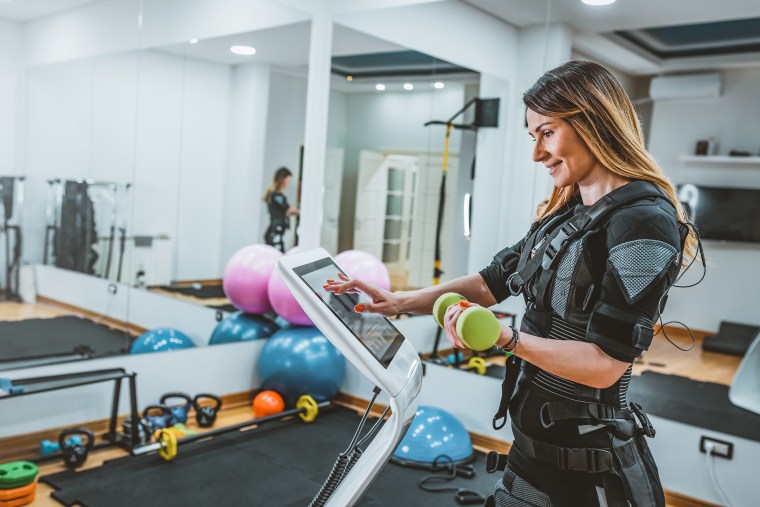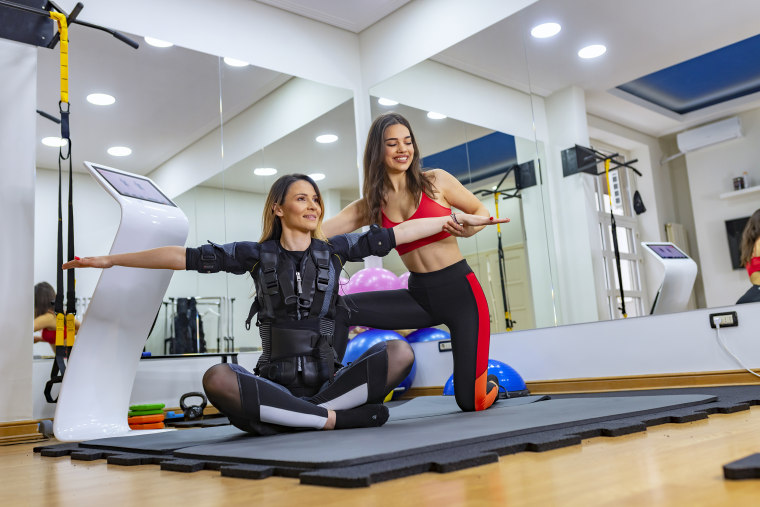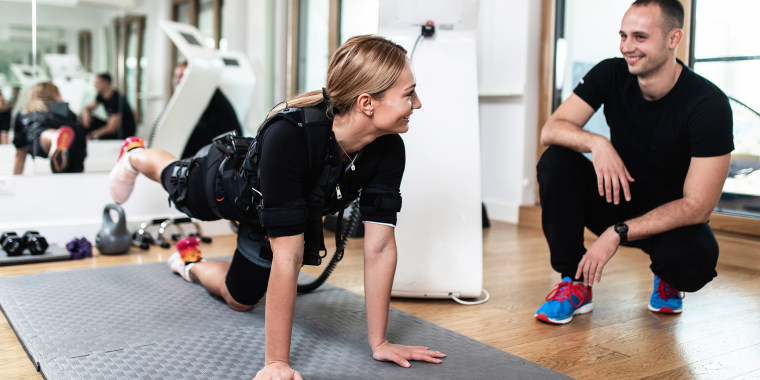The idea of adding tiny bursts of electricity to your workout may sound a painful, torturous idea - but according to some studies, it can make workouts even more effective for some people.
EMS, short for electrical muscle stimulation, is a "general term for the use of electrotherapy," according to Dr. Karena Wu, the owner and clinical director of ActiveCare Physical Therapy. There are multiple types of that muscle stimulation, but according to Wu, the most common kinds for a workout would be "Russian stimulation or high frequency stimulation," which helps to strengthen the muscles.
"The stimulation typically is on a pulsed setting, so that as you contract the muscle, the stimulation works together with the muscle contraction to heighten it," Wu explained. "The stimulation helps to recruit more muscle fibers and can help with timing of contractions, making them contract faster to perform a movement."
Former TODAY co-host Kathie Lee Gifford swears by the method, talking about it in a recent Instagram interview. She said that she goes to a Manduu studio, which pairs the county's first Food and Drug Administration (FDA) approved EMS training program with small class sizes and personalized regimens to help build muscle and lose weight.
"I’ve got muscles I didn’t have in my 20s when I was young and firm and in great shape," Gifford said. "It’s pretty spectacular. ... I highly recommend it. I don’t love to exercise but this is something I do ‘religiously.’"
How does EMS work?
EMS generally works by placing electrodes on various body parts or muscle groups. Like Wu described, EMS works by stimulating whichever muscle is being worked to heighten the contraction, making it stronger. Sometimes, the electrodes are applied with sticky pads; other methods use vests with electrodes in them.
According to the Manduu program that Gifford referenced, working against the electronic pulse should feel "hard, like you are moving through molasses or mud," but not painful. Warren G. Darling, Ph.D., chair of the department of healthy and human physiology at the University of Iowa, disputed that description, saying that the amount of electricity a workout would require to be effective would be somewhat painful, but could be adjusted based on a user's tolerance.

"For the stimulation to be strong enough to strongly activate muscles is painful," he said. "What it feels like is like a cramp. If you do it isometrically, it’s not as bad, but it also is painful right at the spot (where the electrode is placed)."
Who is EMS effective for?
Electrical muscle stimulation began as a way to work with people with neuromuscular issues, helping them contract muscles that may be difficult to use. Darling, who primarily studies EMS used in this way, said that it can be especially helpful for people suffering from multiple sclerosis.
"(EMS) allows them to do more exercise than they otherwise could, because you're not having to exert the same effort because the stimulation is helping you do the exercise," Darling explained.
The workouts can also help people who are paralyzed.
"If it's a spinal cord injury and they can't control their muscles at all, then (the movement) is all driven totally by EMS," Darling said. "For people with high spinal cord injuries that can't control upper limbs, they'll use EMS to pick things up and control the muscles of their hands so they can grasp and pick something up, but it's difficult. ... There it's not really exercise, it's just literally using (EMS) to do movements that the person can no longer do."
Darling said that there has been some research into athletes already in peak condition using the muscle stimulation.
"I've seen studies where EMS is used in people after ACL injuries, otherwise healthy people," he said. "They compared doing electrical stimulation training to the person just training themselves, and they got fairly similar results, because they basically matched the level of training. The question is, if you superimpose EMS while you're already making a strong effort, are you going to activate muscle fibers or motor units that are really hard to train?"
Nicholas Rodio, Ph.D., an instructor in the physical therapy department at the University of Scranton, said that EMS can benefit most people, but it can only enhance your workout, not replace it entirely.
"Are you going to get monstrous six pack abs from doing some of this stuff? That jury is still out," he said. "It also depends on what else you're doing. So if you just put the (EMS electrodes) on and stand there, you're not going to get the same result as the person who's putting the (electrodes) on and powerlifting."
Are EMS workouts safe?
EMS can be done in either supervised settings or with over-the-counter products, but some experts urged caution in using those at-home options.
"Never use anything, especially something like this, without consulting a medical professional," said Rodio. "You should always consult with someone before you buy something over the counter and put it on. ... By putting it on and doing activity like going to the gym and lifting away with this electrical stimulation, if you're not used to it, you can certainly put yourself at risk for an accident."

There is also some risk of burns or skin damage from the electrodes.
"The biggest danger from using electrical stimulation and using the sticky pads to generate the current is that if the pad does not have good contact, are not at full integrity (again like a poor contact between the skin and the pad) or the frequency is set too high and is uncomfortable, there can be skin breakdown and damage," said Wu. "It can also hurt as the current goes through you, much like giving you a 'zinger'."
Anthony Carusotto, an instructor in the physical therapy department at the University of Scranton, also warned again trying to amp up workouts too quickly while using the stimulation.
"I would worry about someone inappropriately using this and going beyond the muscle threshold, and maybe is causes more tension in the muscle that it can handle," he said. "Now we start to see inflammation build up, we might see small tears or strains in a muscle, or even worse, a rupture of the tendon off the bone of the origination site. The biggest downfall is not knowing what you're doing."

